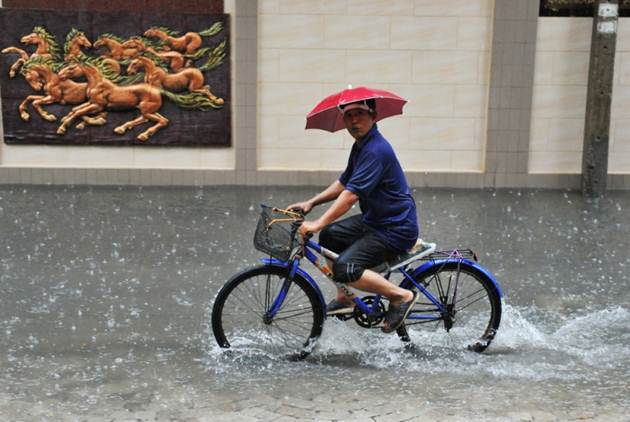Which Taiwanese Cities are Truly Prepared?
When Flooding, Heatwaves, Droughts Become the Norm in Taiwan

Source:Shutterstock
Typhoons, extreme heat, and landslides were cited as the most frequently seen hazards. With this in mind, how can Taiwan’s cities cope?
Views
When Flooding, Heatwaves, Droughts Become the Norm in Taiwan
By Kwang-Yin LiuFrom CommonWealth Magazine (vol. 686 )
As the impact of global climate change worsens, such phenomena once considered anomalous such as typhoons, droughts, and the urban heat island effect will eventually become the norm. A full 55 percent of the world’s population resides in urban regions, and dense populations will force cities to take climate hazards seriously. According to the latest report from the London-based CDP (Carbon Disclosure Project), released in late October, in response to a CDP questionnaire, fewer than half of Taiwan’s 20 cities and counties had disclosed the climate hazards faced by their respective municipalities. Typhoons, extreme heat, and landslides were cited as the most frequently seen hazards. With this in mind, how can Taiwan’s cities cope?
According to the report, among 620 cities worldwide self-reporting their climate change risks, 85 percent, or 530 of the cities, are currently at risk from the impacts of climate change. The three major natural disaster risks named were flooding (71%), extreme heat (61%), and drought (36%).
In other words, the living security, transportation safety, and even physical and mental well-being of nearly 520 million residents in over 500 cities worldwide are all subject to the impact of the climate, with increasingly high-stakes risks.
Climate Becoming a Risk of Municipal Governance That Cannot Be Overlooked
Shirin Reuvers, Associate Director of Cities, States and Regions for the Berlin-based CDP (Carbon Disclosure Project) Europe, stresses that when looking at the impact of climate change on people’s lives, cities are a key yardstick for observation.
“It’s because most of the world’s population resides in cities,” she pointed out during an interview. The biggest advantage of allowing cities to examine their climate vulnerabilities through data and information is in reminding city managers to maintain vigilance at all times, and help the public heighten its consciousness.
Founded in 2000 in the United Kingdom, the Carbon Disclosure Project’s chief mission is to encourage enterprises and cities to disclose their carbon dioxide emissions and expose them among climate change risks as indices for the reference of global investors.
Beginning in 2010, the CDP entered the realm of cities through the disclosure of corporations’ information. At first, only 50 cities completed “climate performance” questionnaires, but over 800 cities worldwide participated this year.
Reuvers relates that both Taipei and Kaohsiung have completed climate vulnerability questionnaires every year since 2010, indicating the sound consciousness of their respective city administrators.
What is particularly remarkable about this year’s report? Reuvers offers that this year marks the first time that the CDP has tallied and disclosed hazard scores for each city. This was done with the intention that, after having accumulated sufficient data, each city can conduct long-term observation of responses to climate change risks, and compare notes with other cities.
Still, Reuvers stresses that a higher climate hazard rating than other cities is not necessarily a bad thing, as the method for calculating the rating gives cities the opportunity to evaluate the severity of each climate hazard themselves, then tally up the sum. Although higher scores indicate higher risk, cities’ self-awareness is a good thing.
The city of Taipei, for instance, had a hazard score of nine. Although that falls on the high side, Reuvers offers that it shows that Taipei is taking its vulnerabilities seriously and is giving thought to various responses.
Taipei proposed various response approaches in the questionnaire, such as a disaster warning system and green rooftops. “It’s clear to see that, since they started answering the questionnaires eight years ago, Taipei and Kaohsiung have gotten a better idea year by year of the climate change hazards they face and how they might respond.”
Self assessment of climate hazards is like conducting a health checkup, where even if too many red numbers cause alarm and consternation, at least the risks are known. And in that knowledge, concerted effort can be devoted to thinking about how to make improvements or formulate responses.
Shirin Reuvers recommends that every city conduct a serious climate risk vulnerability assessment and share information, so that cities can learn from each other.
Reuvers notes that there are even things that Europe can learn from Taiwan. For instance, Europe has experienced rare heat waves in recent years, with Berlin being visited by increasingly strong winds in the autumn and winter months, resulting in electric trolley stoppages. This is an unprecedented situation.
“This reminds us that European cities actually have a lot to learn from Asian cities, like how to respond to weather conditions never previously encountered, such as heavy winds and extreme heat,” Reuvers says.
In respect to the Taiwan cities climate risks disclosed by the CDP, Hsu Huang-hsiung, deputy director of the Research Center for Environmental Changes at Academia Sinica, relates that the number of cities vulnerable to climate risks is clearly on the rise, which research shows is mainly demonstrated by flash flooding, high temperatures, and droughts.
From Floods to Droughts - Shape of Things to Come
According to Hsu, research indicates that, although the number of summer afternoon thundershowers could decrease in the future in the northern Taipei region, they will increase in intensity. The reason is that the meteorological conditions for afternoon thundershowers is low-level advection moisture condensation. Normally, moisture rises when it collides with hillsides or mountains, causing mountain rains. However, the heat island effect of increased urbanization can lead to increased moisture production.
 Source: Shutterstock
Source: Shutterstock
Intense afternoon thundershowers can cause inner flood damage. Hsu notes that certain areas of Taipei, such as Gongguan and Zhongxiao East Road, could experience flooding of increasing severity from summer afternoon thundershowers. With this in mind, he recommends that Taipei enact such response measures as strengthening its drainage system, and increasing natural vegetation and green spaces.
Climate change models predict that by the century’s end, the number of extreme hot days could increase by three- to five-fold from the present; thus it can be inferred that heatwaves in Taiwan will increase in severity, with higher temperatures. Climate change models show all the hotspots in urban environments.
The paradox is that when it rains it floods, and when it does not, drought occurs. Unfortunately, these extremes could appear in greater frequency, and especially acutely, in cities.
Have you read?
♦ Taiwan: The Water-starved Island
♦ Scholars: Taiwan Should Relocate Its Capital
♦ What Keeps Taipei 101 Steady During Earthquakes and Typhoons?
Hsu relates that Academia Sinica released a report on northern Taiwan drought study program outcomes, noting that by the mid-century (2040 to 2060), northern Taiwan could experience an increased frequency of spring droughts, resulting in a reduced volume of water flow in rivers and streams in the northern region, which would have a significant effect on water for public use.
Hsu cites the example of the Ministry of Economic Affairs’ Ban-Xin Water Provision Improvement Plan, noting that it was created so that the cities of Taipei and New Taipei could both draw drinking water from the Feicui Reservoir. Under the plan, water from the reservoir, which currently has a relatively ample supply, would be transported to Banqiao, Xinzhuang, Taoyuan, and even Hsinchu.
By the middle of the century, given the impact of climate change, springtime water shortages in northern Taiwan could be more severe than today, having a more marked impact on water for agricultural use.
Only by taking such measures such as promoting water conservation, saltwater desalination, or urging heavy industrial water users to autonomously develop water recycling methods, can future droughts be effectively addressed.
Concerning the urban heat island effect, Hsu cites research indicating that by 2035, the average temperature in northern Taiwan will increase by 0.4 degrees Celsius, leading to a marked impact of heat exhaustion cases and heat waves.
(Read: Lychees and Longans Could Become Impossible to Get at Any Price)
Lin Chuan-yao, a research fellow at the Academia Sinica Research Center for Environmental Changes, focuses his research exclusively on the impacts and adjustments to climate change on an urban scale.
Examining temperature data for Taipei, Taichung and Kaohsiung from the past 40 years, Lin found that the heat island effect was the most marked for Taipei due to its concentration of concrete buildings, motor vehicles, and people. Over that 40-year period, the average nighttime temperature has risen by two degrees, and the average daytime temperature by one degree, exceeding that of both Taichung and Kaohsiung.
 Source: Lin Chuan-yao; data for 1971-2010, temperature in July and August in Taiwan’s three largest cities
Source: Lin Chuan-yao; data for 1971-2010, temperature in July and August in Taiwan’s three largest cities
In response to the heat island effect, Hsu Huang-hsiung calls for a systematic response, starting with urban planning. He relates that currently many city planners have begun taking into consideration the idea that urban design must facilitate air circulation, and that buildings can mitigate the heat island effect with building methods and materials. For instance, greenery has in recent years been grown on a perimeter wall outside a downtown London glass-encased structure mockingly known as the “Gherkin Building” in an effort to lower temperatures and conserve electricity.
Lin notes that in recent years more and more cities have been discussing the incorporation of the WetBulb Globe Temperature (WBGT) index into weather forecasting, not only looking at temperature but also giving further consideration to such factors as humidity, heat radiation, and wind speed. For instance, in Japan the WBGT index is often taken into consideration in relation to sporting events, and strenuous outdoor activities are recommended to be avoided when the index is high.
“By the end of the century, high temperatures within cities will become the norm, and more than 50 percent of the time during the summer will have a negative impact on human health,” asserts Lin.
“If we don’t respond to climate change, the fruits of social and economic growth established over the past several decades could all be erased. Cities must build resiliency to protect citizens from the effects of extreme weather.”
According to CDP, 70 percent of the global population will reside in cities by the year 2050. Cities, which occupy just two percent of the earth’s surface, not only contribute over 70 percent of greenhouse gases, but take the brunt of the impact of climate change.
Beyond Taiwan, all cities should conduct detailed climate vulnerability and risk assessments. And only through honest assessment can we prepare for a changing future.
Translated by David Toman
Edited by TC Lin, Sharon Tseng












